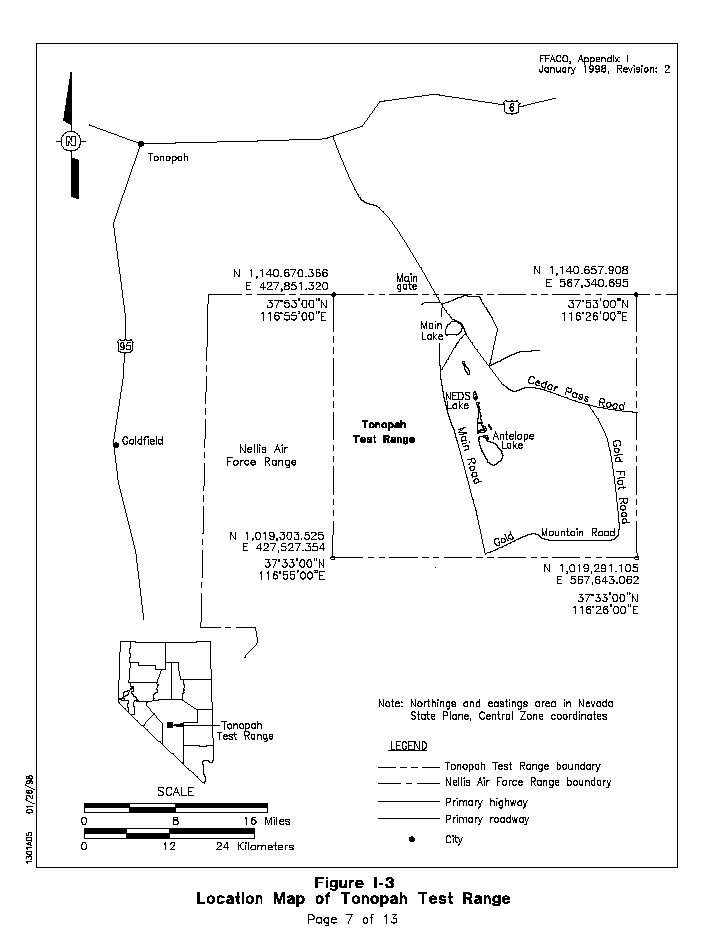The EEOICPA was passed in 2000. It provides compensation to workers who became ill as a result of their employment manufacturing nuclear weapons in the USA, as well as their spouses, children, and grandchildren. Tonopah Test Range EEOICPA coverage is available for qualified former Workers and their families.
Are you eligible for compensation? If you or a family member worked at this or another DOE facility and became ill, you may be entitled to compensation of up to $400K plus medical benefits. Call EEOICPA Counsel Hugh Stephens at 1-855-548-4494 or fill out our free claim evaluation, We can help even if you’ve already filed, even if your claim was denied!
Here, we have compiled publicly available information and documentation about the facilities covered by the Act to clarify how their activities relate to the Energy Employees Occupational Illness Compensation Program Act.
Tonopah Test Range
State: Nevada
Location: Tonopah
Time Period: 1956-present
Facility Type: Department of Energy
Facility Description: The Tonopah Test Range was established by Sandia Corporation and continues today as an outpost to Sandia National Laboratories. Tonopah was established to provide an isolated place for the Atomic Energy Commission to test ballistics and non-nuclear features of atomic weapons. The AEC began leasing this isolated 525 square mile property from the Air Force in early 1956. In August of the same year the AEC contracted Reynolds Electrical and Engineering Company (REECO) for the construction of temporary facilities on the test range. The AEC contracted with Lembke Construction for permanent facilities at the site in 1960.
Rocket testing began in 1957 with the series “Doorknob.” It is believed that the only operation on site involving radiation occurred in 1963 and was known as Operation Roller Coaster. Studies were also conducted in 1964 at the Tonopah test range as part of the AEC program known as ProjectPlowshare. These involved the use of non-nuclear explosives to examine earth cratering patterns.
A separate Air Force installation at the test range, which consisted of housing, hangers, and other facilities standard to modern Air Force bases, was constructed on the Tonopah Test Range in the late 1970s for developmental testing of the Air Force’s F-117 Stealth Fighter plane. The Air Force moved its stealth program Holloman Air Force Base and mothballed its Tonopah base in 1994. The Air Force installation does not qualify as a DOE facility.
CONTRACTORS: REECO; Lembke Construction of Las Vegas, EG&G, and Advanced Security. Raytheon also served as a contractor at the site, and in the 1993, KMI received Tonopah’s primary support and maintenance contract.
Listing:
Tonopah Test Range is listed as a Department of Energy (DOE) site under the EEOICPA.
Compensation:
As of 05/31/2015, the total compensation paid under Parts B and E of the EEOICPA, including medical compensation, for workers suffering from the effects of having worked at the Tonopah Test Range is $30,019,680.
*Tonopah Test Range
Portions of the Tonopah Test Range, located in Nye County, and the activities thereon, have been managed by the AEC or the DOE for the U.S. Department of the Air Force since an initial Memorandum of Understanding was signed in 1956. Approximately 370,000 acres were designated to support research related to the weapons development program (map). DOE has responsibility for remediation efforts on the Tonopah Test Range for those sites resulting from past DOE activities. As described in a Memorandum of Understanding dated April 1, 1969, the boundaries are as follows:
An area approximately 24 by 26 miles starting from a point on the northern boundary of the Nellis Air Force Range at approximately 37E 53′ N – 116E 26′ W, thence 26 miles west to approximately 37E 53′ N – 116E 55′ W, thence south to approximately 37E 33′ N – 116E 55′ W, thence 26 miles east to approximately 37E 33′ N – 116E 26′ W, thence 24 miles north to point of beginning.
*Source


















